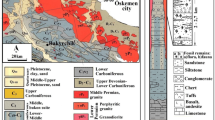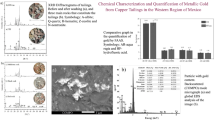Abstract
Seven mineralogical-geochemical types of ores have been identified in the gold orogenic deposits of Uzbekistan: /Au-W/Au-Bi-Te/Au-As/Au-Ag-Te/Au-Ag-Se/Au-Sb/Au-Hg/. Non-industrial are Au-W and Au-Hg. For each industrial type, certain gold compounds are characteristic: maldonite, Au-arsenopyrite and Au-pyrite, petzite, physhesserite, petrovskaite, aurostibite, which form regular micro- nanoensembles with the corresponding minerals Bi, Te, Se, S, As, Sb. They are direct indicators of the type and technological properties of ores. Pyrite and arsenopyrite are preserved in the processing wastes of Au-Bi-Te and Au-As ores, in which gold (901‰), maldonite (Au2Bi), headleyite (Bi7Te3) and others were detected, 300–700 nm in size. Waste is suitable for the secondary extraction of gold.
You have full access to this open access chapter, Download conference paper PDF
Similar content being viewed by others
Keywords
1 Introduction
The Republic of Uzbekistan is one of the leading gold mining countries in the world. Such large deposits as Muruntau, Myutenbay, Kokpatas, Zarmitan and others (Kyzylkum-Nurata ore region) are known. As a result of many years of production, the mining and processing industry faces the problem of transition from oxidized ores with large “free” gold to the processing of refractory ores with “invisible” gold. One of the effective approaches to the assessment of such ores is the use of nanotechnology, nanomineralogy and nanogeochemistry (Hochella 2002; Koneev et al. 2010).
2 Methods and Approaches
The section of mineralogy that studies the conditions of formation, the physicochemical properties of natural compounds, the size of which, at least in one dimension, enters the nanoscale (10−6–10−9 m) is called nanomineralogy. There are nanominerals that are formed by the “down-top” technology, from atoms to chemical compounds, and nanoparticles that are formed by the “top-down” technology during dispersion. The anomalous properties of nanominerals and nanoparticles are determined by a significant increase in the specific surface energy. As a result of “size effects”, nano-objects acquire high chemical, catalytic, sorption activity and other properties. “Noble”, chemically inert gold in the nanostate becomes active and is found in ores not only in the form of native, but also in the form of a compound with various elements up to sulfur and oxygen. When studying ores, the main focus is on ore minerals. Non-metallic minerals, carbonaceous material rather negatively affect the enrichment processes, making it difficult to crush, float or adsorb gold. The study of mineralogy and nanomineralogy is important due to the fact that minerals of different composition and size differ in their ability to crush, float, or cyanate. The studies used an electron probe microanalyzer Superprobe JXA-8800R, Carl Zeise Oxford instrument (SEM-EDX); ICP MS 7500 Agilent Technologies.
3 Results and Discussion
The gold ore deposits of the Kuzylkum-Nurata region of Uzbekistan are confined to the South Tien Shan orogenic belt. Placed in the “black” shale, terrigenous, carbonate, volcanogenic and intrusive rocks. Tails of ore enrichment stored in long-term facilities were also studied. It has been established that in the orogenic deposits of the Kyzylkum-Nurata region, seven mineral-geochemical ore types are developed: /Au-W/Au-Bi-Te/Au-As/Au-Ag-Te/Au-Ag-Se/Au-Sb/Au-Hg/. Each type differs in the ratio of non-metallic and ore (sulphide) minerals, but primarily in the composition of micro-nanoensembles of minerals, compounds and gold fineness. In the studied deposits, the leading industrial ones are Au-Bi-Te, Au-As, Au-Ag-Se, Au-Sb (Table 1). In addition to native gold, electrum and kustelite, maldonite, Au-arsenopyrite, Au-pyrite, petzite, calavertite, fishesserite, petrovskaite, aurostibite were detected in ores. Gold release forms and its micro- nanoanesmble in ores in Fig. 1, row I. The study of Au-Bi-Te and Au-As ore tails showed that some of the sulfide minerals still remain, in which the nanoforms of gold, its compounds and associated bismuth tellurides are preserved 300–700 nm in size (Fig. 1, row II).nts.
Micro-nanomineral forms of gold release and its compounds in various types of ores (I) and tails (II). a - maldonite, Bi-tellurides in arsenopyrite; b - gold, arsenopyrite in arsenic pyrite; c - aurostibite with arsenopyrite in antimonite; d - nanogold in pyrite; e - maldonite and hedleyite and arsenopyrite; f - hedleyite in arsenopyrite.
4 Conclusions
As a result of the research the following were established: - Seven mineral-geochemical types of ores were identified in the orogenic deposits of the Kyzylkum-Nurata region of Uzbekistan: /Au-W/Au-Bi-Te/Au-As/Au-Ag-Te/Au-Ag-Se/Au-Sb/Au-Hg/. Industrial types are /Au-Bi-Te/Au-As/Au-Ag-Se/Au-Sb/ ores possessing different technological properties; - Gold is represented by its native type, electrum, cyustelite, maldonite, petzite, aurostibite, fishesserite, petrovskaite, Au-arsenopyrite, Au-pyrite, forming micro- nanoensembles with the Bi, Te, Sb, Se, As, S minerals; - Pyrite and arsenopyrite remain in the enrichment tails of Au-Bi-Te and Au-As ores, in which nanoinclusions of gold, maldonite and bismuth tellurides are found. Tails are recyclable; - Nanotechnological methods allow to increase the efficiency and unambiguity of exploration, assess the prospects for hidden and unconventional deposits, as well as assess the technological properties of ores and enrichment tails for their complete processing.
References
Hochella M (2002) There’s plenty of room at the bottom: nano-scince in geochemistry. Geochem Cosmochem Acta 66(5):735–743
Koneev RI, Khalmatov RA, Mun YS (2010) Nanomineralogy and nanogeochemistry of ores from gold deposits of Uzbekistan. Geol Ore Deposits 52(8):755–766
Acknowledgements
The authors are grateful to the Navoi Mining and Metallurgical Combinate for their assistance in research.
Author information
Authors and Affiliations
Corresponding author
Editor information
Editors and Affiliations
Rights and permissions
Open Access This chapter is licensed under the terms of the Creative Commons Attribution 4.0 International License (http://creativecommons.org/licenses/by/4.0/), which permits use, sharing, adaptation, distribution and reproduction in any medium or format, as long as you give appropriate credit to the original author(s) and the source, provide a link to the Creative Commons license and indicate if changes were made.
The images or other third party material in this chapter are included in the chapter's Creative Commons license, unless indicated otherwise in a credit line to the material. If material is not included in the chapter's Creative Commons license and your intended use is not permitted by statutory regulation or exceeds the permitted use, you will need to obtain permission directly from the copyright holder.
Copyright information
© 2019 The Author(s)
About this paper
Cite this paper
Koneev, R., Khalmatov, R., Tursunkulov, O., Krivosheeva, A., Iskandarov, N., Sigida, A. (2019). Nanotechnologies in Mineral-Geochemical Methods for Assessing the Forms of Finding of Gold, Related Elements, Technological Properties of Industrial Ores and Their Tails. In: Glagolev, S. (eds) 14th International Congress for Applied Mineralogy (ICAM2019). ICAM 2019. Springer Proceedings in Earth and Environmental Sciences. Springer, Cham. https://doi.org/10.1007/978-3-030-22974-0_22
Download citation
DOI: https://doi.org/10.1007/978-3-030-22974-0_22
Published:
Publisher Name: Springer, Cham
Print ISBN: 978-3-030-22973-3
Online ISBN: 978-3-030-22974-0
eBook Packages: Earth and Environmental ScienceEarth and Environmental Science (R0)





